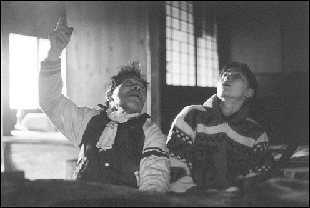|
|
| Director, Editing: Kawase Naomi Photography: Kawase Naomi, Koide Junko Producers: Fuseya Hiroo, Kawase Naomi Production Company, Source: Bitters End 10-5-101 Sakuragaoka-cho, Shibuya-ku, Tokyo 150-0031 JAPAN Phone:81-3-3462-0345 / Fax: 81-3-3462-0621 JAPAN /1997/ Japanese/ Color/16mm/73 min |
Born in 1969 in Nara. After graduating from the Osaka School of Photography (currently the School of Visual Arts) in 1989, worked as a lecturer at the school for four years. In 1993, Embracing, which put on film her search for the father who abandoned her in her youth, won the Encouragement Award at the Image Forum Festival and White Moon, her fiction film set in Nara, was invited to show at the Pia Film Festival. At the Yamagata International Film Festival '95, Embracing was given a Special Mention FIPRESCI Prize and Katatsumori, her portrait of the grandmother who raised her, won an Award for Excellence in the New Asian Currents program. As her films began showing at festivals in Japan and abroad, she formed Kumie in 1993 and Kumie, Ltd., in 1995. At the Yokohama Museum of Art in 1996, organized and selected films for "Kirara," a program of domestic films held in March, and in May managed the 16mm production "Grab the Light" that was open to general participation. That summer directed and wrote the screenplay for her first 35mm fiction film Suzaku, which in 1997 won the FIPRESCI Prize at the Rotterdam Film Festival, the Best Actress Award at the Singapore Film Festival, and the Camera D'Or at the Cannes Film Festival. Completed her new film, The Weald, in 1997. |
 |
|
| The Weald is a portrayal of six groups of elderly people living in the
mountains of Yoshino, Nara Prefecture. Kawase Naomi goes straight
to their hearts, keenly listening to their stories. Refusing to
analyze their lives, she describes these people just as they are.
Led along by inserts of a mournful melody, the film weaves together
the solitude of a single woman nearing old age, the sadness of
a couple who have lost a child, and the dreams of the villagers.
People leave, and the villagers continue to live their modest
lives unable to regain their past energy. Kawase's remarkable
fieldwork and flexible personality allow the optimistic expressions
and brave gestures of these people to shine through their melancholic
lives. Just when you think her versatile camerawork has captured
the villagers in sunlight, pictures of the transparent wind blowing
over a dirt floor and a forest of lacquer-like trees visualize
the time and climate of the village. It suddenly comes to mind
that this is what the Japanese homeland was like. --Fuseya Hiroo |
|
|
|
Director's Statement The Japanese title for The Weald is "Somaudo monogatari," a phrase that includes the unusual ideograph "soma." It, like the word "weald," has a nostalgic, old-fashioned ring to it. When I asked an acquaintance how to write it, I was told it combined the character for "tree" with that for "mountain." I tried writing it myself and asked what it meant. The reply was that things relating to people who live in the mountains have generally been referred to as "soma" for ages. That made sense. The minute I first heard and wrote this word, I fell in love with it. If you change the "tree" part of the ideograph to the character "people," it becomes "sen" or "hermit." Hermits are people who've been able to transcend everyday existence, aren't they? Now that I think about it, a long time ago I once made my mother mad pleading with her to teach me how to become a hermit. "Somaudo" adds the ideograph for "people" to "soma." I was given a lot of hints on how to enrich life from the soma people who live in Hirao, Nishiyoshino-mura, Nara Prefecture. The accumulation of their lived days has taken root in the earth and returned to nature. Just as massive trees withstand the wind and the rain, the cold and the heat, these people endure the twists and turns of life by simply existing, developing deep wrinkles. Replacing the "facts" of the life they have spun with my own " truth, " I spin a tale in cinema, so that this may become a film that continues from the past to the present, the present to the future. |
